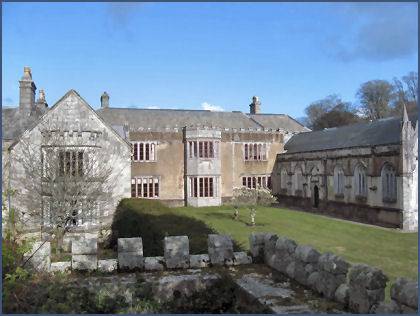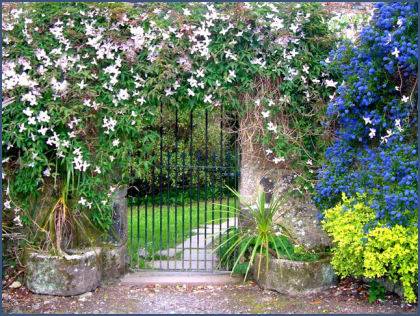Trelowarren House
OS Grid ref:-
 Historic Trelowarren House is situated near to the Helford River on the eastern side of the Lizard Peninsula
Historic Trelowarren House is situated near to the Helford River on the eastern side of the Lizard Peninsula
The privately owned estate is surrounded by a thousand acres of highly attractive woodland and farmland between the Goonhilly Downs and the Helford River.
The earliest known owner of the Manor of Trelowarren, as recorded in the Domesday Book of 1086, was the Saxon King Harold Godwineson, who died at the Battle of Hastings.
A garden has been recorded at Trelowarren since medieval times. The estate came into the possession of the influential Vyvyan family, originally of Treviddren, in 1427, by mariage to Honora Ferrers daughter and heiress of Richard Ferrers of Trelowarren.
Hanniball Vyvyan was governor of St. Mawes Castle during the reign of Queen Elizabeth I. During the English Civil War, the Vyvyan family threw in their lot behind the king and Sir Richard Vyvyan, the first baronet, recieved a knighthood from King Charles I. The house still has a room called the King Charles Room, were it is believed that the furture Charles II may have stayed in 1646. A portrait by Sir Anthony Van Dyck of Sir Richard and of King Charles I which was presented to the Vyvyan family by King Charles II still hang at Trelowarren. Another Sir Richard Vyvyan was imprisoned in the Tower of London by King George I, who suspected he favoured the claims of James Francis Edward, the Stuart Pretender to the throne.
 The house and gardens were remodelled in the Georgian era, when the chapel was decorated with Strawberry Hill Gothic plasterwork. Gardens were planted to the south of the house. Lady Vyvyan’s Garden is one of three walled gardens, its walls contain gothic windows and a turret. Another of these enclosed gardens boasts a building in the style of a temple, which once served as a library. During the First World War the family had to leave the house when it was commisioned by the army. The estate is currently owned by Sir Ferrers Vyvyan who plans to restore the gardens to their former glory.
The house and gardens were remodelled in the Georgian era, when the chapel was decorated with Strawberry Hill Gothic plasterwork. Gardens were planted to the south of the house. Lady Vyvyan’s Garden is one of three walled gardens, its walls contain gothic windows and a turret. Another of these enclosed gardens boasts a building in the style of a temple, which once served as a library. During the First World War the family had to leave the house when it was commisioned by the army. The estate is currently owned by Sir Ferrers Vyvyan who plans to restore the gardens to their former glory.
There are several earthworks on the estate which date to the Iron Age, the Halliggye Fogou is one of the finest and most extensive of its type in Cornwall. Fogou is a Cornish word meaning cave, Cornish fogous are prehistoric underground passages built by means of excavating a trench and lining the sides with large stone blocks or drystone walling, they are generally roofed with large flat slabs. Very little is known of their intended function. The Halliggye Fogou consists of a long narrow tunnel leading to three sectioned chambers. The fogou was excavated in 1982 after routine ploughing of the then field, when the blade of the plough breached the roof of the main chamber. This hole has since been turned into an entrance stairway for visitors.
There are walks from the estate leading on to the Goonhilly Downs, the Helford River and Tremayne Quay, which was built for the visit of Queen Victoria in 1847.
Restaurant, shop, specialist nursery and local craft display centre.